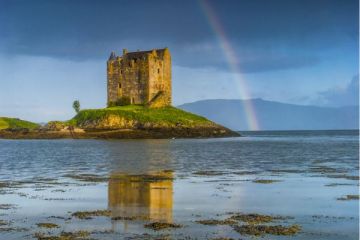
What to See
The tomb, crafted in exquisite Renaissance style, is beautifully carved and stands beneath an elaborate canopy. It was probably created by local masons following a foreign 'pattern book'. The tomb stands in the old 'laird's loft', a grandiose family pew for services.
The timber ceiling of the burial aisle was richly painted by artist JS Stalker with scenes depicting the passage of the seasons and the signs of the Zodiac. The design is meant to mimic stone vaulting, with mock 'ribs' separating panels. A range of family coats of arms are at the top of the ceiling, above Biblical figures. Beneath this are a dozen lines from the Geneva Bible.
These texts are separated by corbels depicting the highly imaginary coats of arms of the Twelve Tribes of Israel. For all these symbolic representations, it is a series of six landscapes that are the real centrepiece. The scenes in each corner represent the seasons, while the two central scenes show an allegory of Largs' location by the shore.
The 'Summer' scene is particularly interesting as it shows Largs Old Kirk and the Aisle itself as they looked centuries before the kirk was pulled down in 1812. Taken as a whole, the landscapes are a remarkable record, showing how Largs looked in the 17th century.
In the family vault beneath the Aisle are the coffins of Sir Robert and his wife, plus the coffin of Sir Hugh Montgomerie of Eaglesham, who fought at the Battle of Otterburn. Sir Robert's coffin is notably long, and even more notable because much of the lead has been stripped from the coffin base.
A local story says that the lead was stolen by local fishermen, who believed that that weights made of lead would help them catch a large number of fish.
Keys to the Skelmorlie Aisle can be obtained from the Largs Museum off Manse Court.
 We've 'tagged' this attraction information to help you find related historic attractions and learn more about major time periods mentioned.
We've 'tagged' this attraction information to help you find related historic attractions and learn more about major time periods mentioned.




